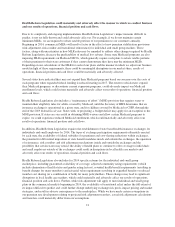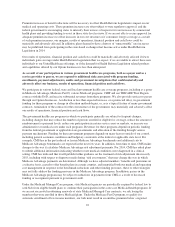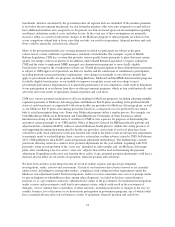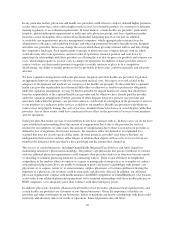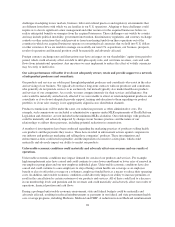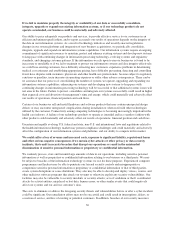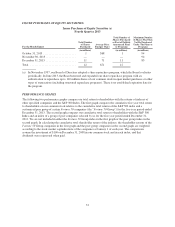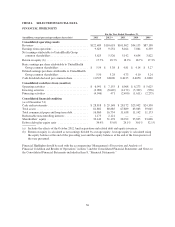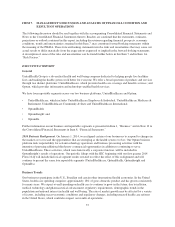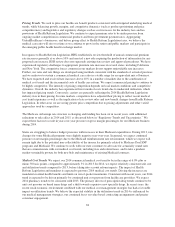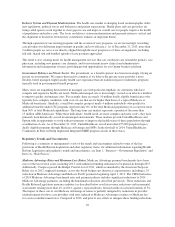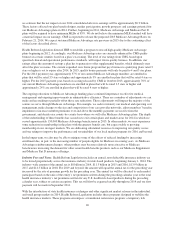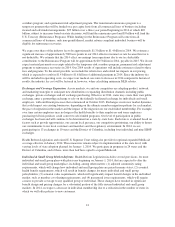United Healthcare 2013 Annual Report Download - page 33
Download and view the complete annual report
Please find page 33 of the 2013 United Healthcare annual report below. You can navigate through the pages in the report by either clicking on the pages listed below, or by using the keyword search tool below to find specific information within the annual report.and the unauthorized dissemination of sensitive personal information or proprietary information or confidential
information about us or our customers or other third-parties, could expose our customers’ private information and
our customers to the risk of financial or medical identity theft, or expose us or other third-parties to a risk of loss
or misuse of this information, result in litigation and potential liability for us, damage our brand and reputation,
or otherwise harm our business.
If we are not able to protect our proprietary rights to our databases, software and related products, our
ability to market our knowledge and information-related businesses could be hindered and our results of
operations, financial position and cash flows could be materially and adversely affected.
We rely on our agreements with customers, confidentiality agreements with employees, and our trademarks,
trade secrets, copyrights and patents to protect our proprietary rights. These legal protections and precautions
may not prevent misappropriation of our proprietary information. In addition, substantial litigation regarding
intellectual property rights exists in the software industry, and we expect software products to be increasingly
subject to third-party infringement claims as the number of products and competitors in this industry segment
grows. Such litigation and misappropriation of our proprietary information could hinder our ability to market and
sell products and services and our results of operations, financial position and cash flows could be materially and
adversely affected.
Our ability to obtain funds from some of our subsidiaries is restricted and if we are unable to obtain
sufficient funds from our subsidiaries to fund our obligations, our results of operations, financial position
and cash flow could be materially and adversely affected.
Because we operate as a holding company, we are dependent upon dividends and administrative expense
reimbursements from some of our subsidiaries to fund our obligations. Many of these subsidiaries are regulated
by departments of insurance or similar regulatory authorities outside the United States such as the ANS in Brazil.
We are also required by law or regulation to maintain specific prescribed minimum amounts of capital in these
subsidiaries. The levels of capitalization required depend primarily upon the volume of premium revenues
generated by the applicable subsidiary. A significant increase in premium volume will require additional
capitalization from us. In most states, we are required to seek prior approval by state regulatory authorities before
we transfer money or pay dividends from our regulated subsidiaries that exceed specified amounts. An inability
of our regulated subsidiaries to pay dividends to their parent companies in the desired amounts or at the time of
our choosing could adversely affect our ability to reinvest in our business through capital expenditures or
business acquisitions, as well as our ability to maintain our corporate quarterly dividend payment cycle,
repurchase shares of our common stock and repay our debt. If we are unable to obtain sufficient funds from our
subsidiaries to fund our obligations, our results of operations, financial position, and cash flow could be
materially and adversely affected.
Any downgrades in our credit ratings could adversely affect our business, financial condition and results
of operations.
Claims paying ability, financial strength, and credit ratings by Nationally Recognized Statistical Rating
Organizations are important factors in establishing the competitive position of insurance companies. Ratings
information is broadly disseminated and generally used throughout the industry. We believe our claims paying
ability and financial strength ratings are important factors in marketing our products to certain of our customers.
Our credit ratings impact both the cost and availability of future borrowings. Each of the credit rating agencies
reviews its ratings periodically. Our ratings reflect each credit rating agency’s opinion of our financial strength,
operating performance and ability to meet our debt obligations or obligations to policyholders. There can be no
assurance that our current credit ratings will be maintained in the future. Downgrades in our credit ratings, should
they occur, could materially increase our costs of or ability to access funds in the debt and capital markets and
otherwise materially increase our operating costs.
31


